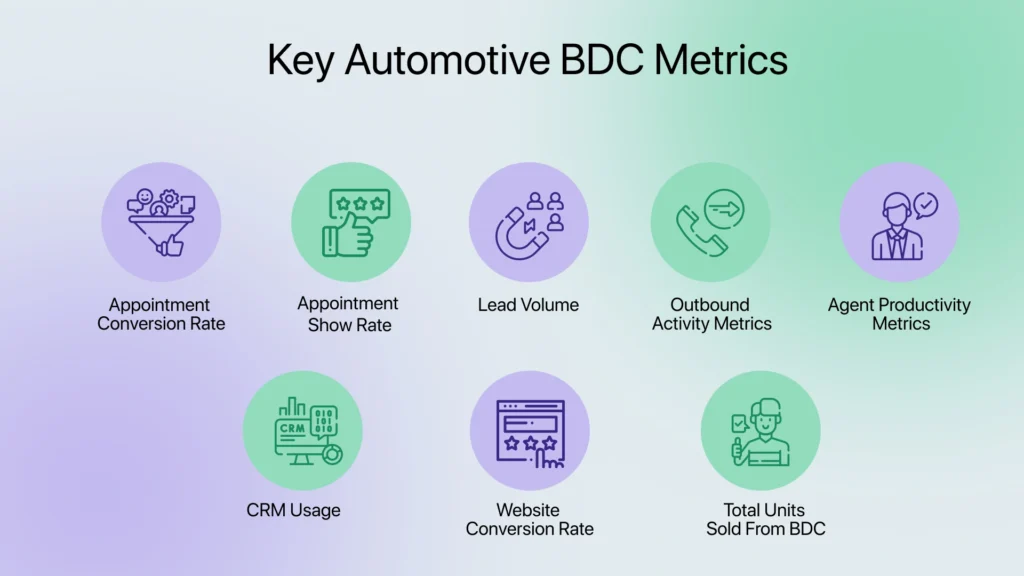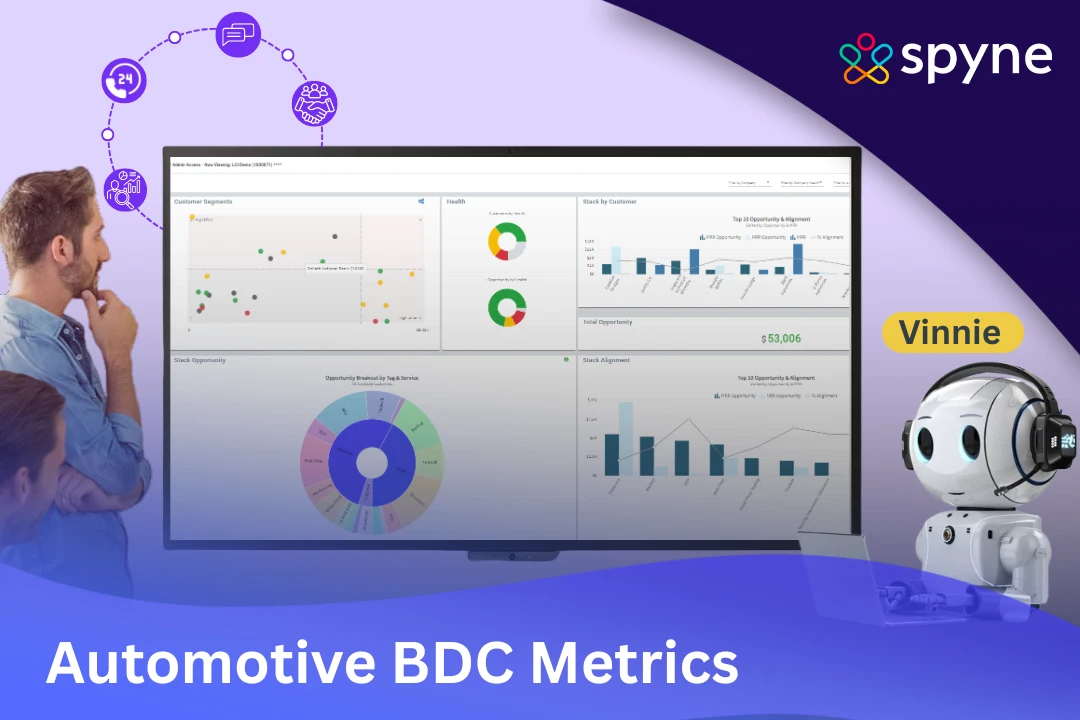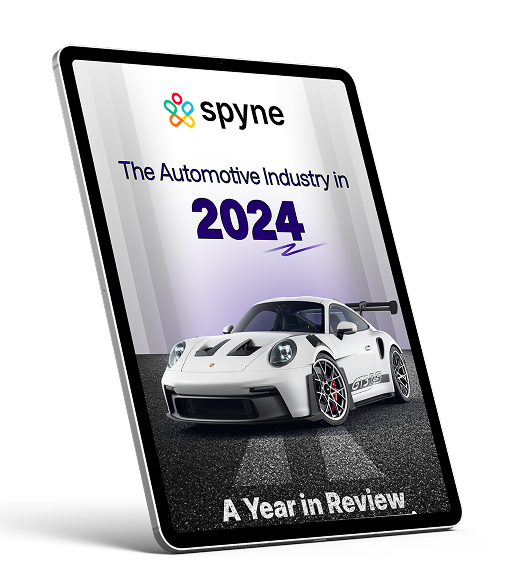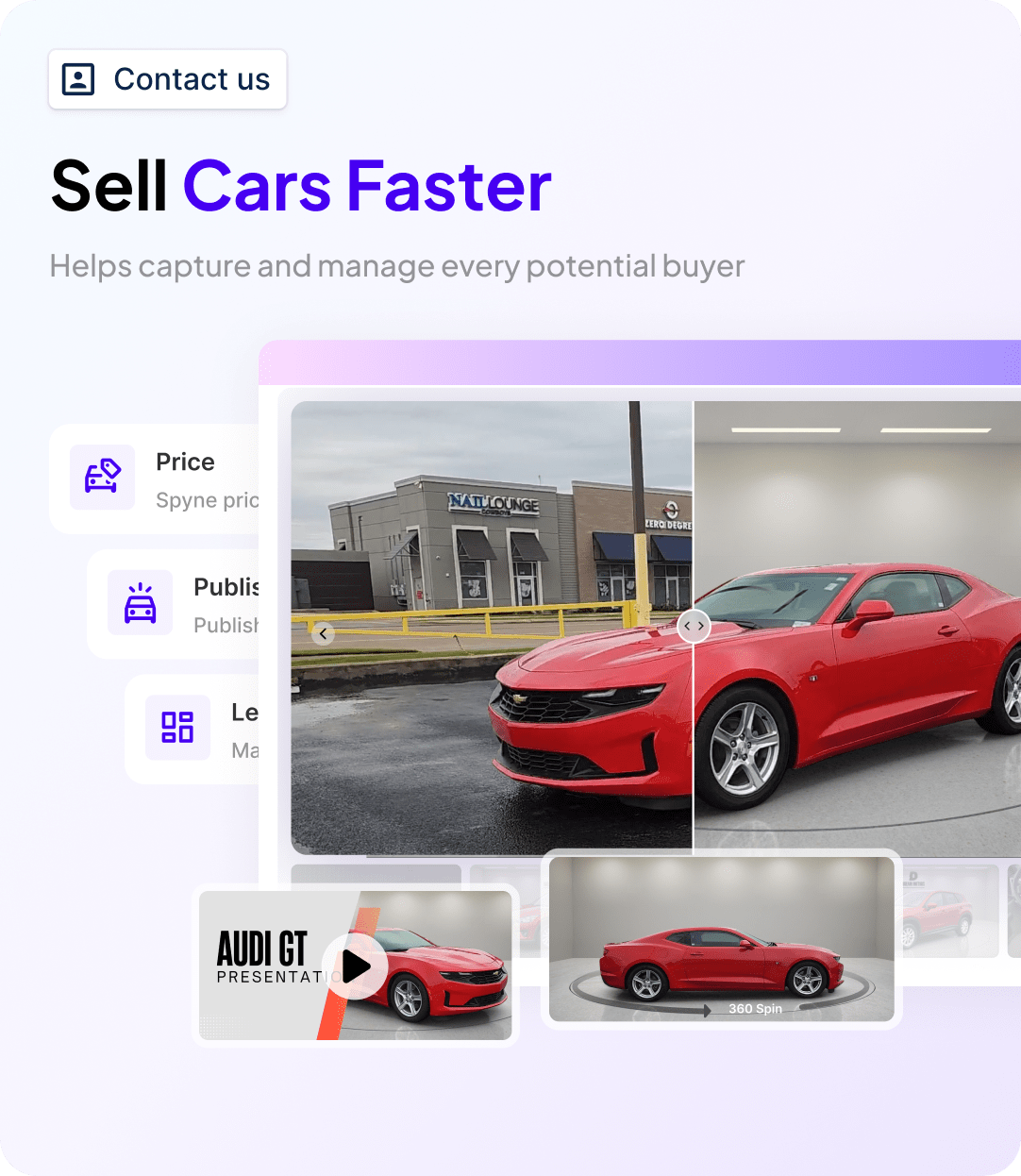Want to grow your car dealership’s revenue in 2025? Start by tracking the right automotive BDC metrics. Today, over 60% of dealership leads come through digital or phone channels, making your Business Development Center (BDC) a key driver of sales. In fact, dealerships that actively track and optimize BDC performance metrics see up to 30% more appointments booked and 25% higher close rates. But without the right data, it’s impossible to know what’s working. This guide breaks down the 12 most important BDC performance metrics that every modern automotive dealership should monitor. From appointment conversion rates to CRM usage and lead quality, we’ll show you exactly how to measure success, fill revenue gaps, and grow your bottom line.
12 Key Automotive BDC Metrics That Drive Real Dealership Revenue
Automotive BDC is more than just a support team in your dealership; it’s a key part of your sales process. To measure how well your BDC is doing, car dealerships need to track the right automotive BDC metrics, not just the basic numbers. These metrics help you see what’s working, where you’re losing leads, and how to improve your sales. Below are the most important BDC performance metrics you should track to grow your dealership revenue.
1. Inbound Appointment Conversion Rate
This is one of the most vital BDC KPI monitoring metrics. It informs you about the number of inbound customer calls that result in booked appointments.
Why it matters: If it’s low, you’re losing warm leads. You want to know not only how many calls are coming in, but how many are actually converting.
How to improve:
- Train reps using proven automotive BDC phone scripts to increase appointment conversions
- Listen in and coach specifically on calls
- Double down on high-converting lead sources
2. Appointment Show Rate
Scheduling is half the victory; showing is the win.
Why it matters: If the customers don’t arrive, your staff wasted effort. The BDC car dealer loses both energy and opportunity. Using tools like an auto attendant phone system can help route calls efficiently and ensure customers receive reminders and confirmations without delay.
How to improve:
- Remind them through text and email
- Reiterate the value proposition in the first call
- Provide flexible time options
3. Lead Volume and Source Analysis
It is important to understand both the amount and source of leads within any automotive BDC division.
Why it matters: Not all leads are created equal. Monitoring volume and quality shows which channels actually deliver. Using AI lead scoring for car dealerships helps identify which prospects are most likely to convert, based on data-driven behavior patterns.
How to improve:
- Tag sources correctly using BDC software or your CRM
- Compare website, referrals, third-party, and walk-in leads
- Reallocate resources to the most profitable channels
4. Outbound Activity Metrics (Calls, Texts, Emails)
Your BDC sales team spends their life on the phone, but texts and emails count too.
Why it matters: Buyers don’t wait. If your BDC doesn’t call within the first hour, they’ll likely buy from someone else. That’s why having an automated lead follow-up system for car dealerships is key; it ensures no lead is left waiting, even during off-hours.
How to improve:
- Build intelligent lead lists for follow-up
- Personalize messaging on every platform
- Track outreach frequency and consistency with a BDC tracker
5. Appointment Set and Conversion Rate
This indicates how good your car dealer BDC is at converting leads into real opportunities. Tracking car dealership conversion rates helps you understand how effective your follow-ups and appointments are at turning leads into actual sales.
Why it matters: Appointments generate showroom visits, and visits generate sales.
How to improve:
- Monitor set and converted appointments
- Reward best-performing agents
- No-shows and aggressively follow up
6. Agent Productivity Metrics
You can’t fix what you don’t measure. That includes specific agent performance.
Why it matters: Time spent on calls, follow-up, and appointments impacts revenue directly.
How to improve:
- Monitor call volume, talk time, and task completion
- Use visual dashboards for real-time feedback
- Provide regular coaching based on actual data
7. Website Conversion Rate
Your site is usually your top source of leads, but only if it converts.
Why it matters: The majority of BDC departments in car dealerships depend a lot on web forms and chat. An average conversion rate is 1 – 3%.
How to improve:
- Optimize landing pages for speed and clarity
- Add live chat and simple lead forms
- Track bounce rate, time on site, and conversion funnels
8. Total Units Sold from BDC
This is the absolute revenue metric: how many vehicles your BDC car store assists moving.
Why it matters: It has a direct correlation to dealership success.
How to improve:
- Connect sales data to the BDC contact
- Develop commission or bonus structures on unit sales
- Use data to see which agents produce conversions
9. Contact Rate and Call Drop Rate
These vital BDC metrics determine how frequently your staff successfully connects, and how frequently customers hang up before reaching anybody.
Why it matters: A High drop rate or a low contact rate indicates inefficiencies in staffing, routing, or timing.
How to improve:
- Shorten hold times and provide call-back options
- Call during high-connect windows
- Put in smart call routing systems

10. CRM Usage and Follow-Up Cadence
Top automotive BDC training programs emphasize regular follow-up, and that begins with CRM discipline.
Why it matters: Efficient CRM equals improved timing, improved personalization, and improved conversion.
How to improve:
- Standardize team CRM workflows
- Automate task and reminder follow-ups
- Track follow-up performance by agent
11. Lead Quality and Qualification Rate
Quality leads lead to sales; bad ones waste the company’s time.
Why it matters: On average, 20 – 40% of leads qualify. Know who’s worth your time.
How to improve:
- Score leads by budget, timeline, and intent
- Use AI tools or BDC software to auto-tag
- Train agents to qualify more quickly on calls
12. Outsourced BDC Performance
If you have an outsourced BDC automotive service, you still must measure performance in the same way.
Why it matters: You’re not giving up control by outsourcing. You’re still accountable for outcomes.
How to improve:
- Establish SLAs and reporting requirements
- Track KPIs weekly
- Sync outsourced agents with in-house sales objectives
Old vs New Automotive BDC Metrics: What Dealers Should Be Tracking in 2025
Back in the day, automotive BDC departments relied on basic, disconnected tools to track performance, mostly spreadsheets, phones, and manual CRM updates. As technology evolved, so did the way dealers measure success. With tools like advanced dashboards, automation, and even virtual BDC automotive models, today’s teams operate with far more speed and accuracy. Below is a side-by-side comparison of old vs new automotive BDC metrics, showing just how far the industry has come.
| Old BDC Metrics | New BDC Metrics |
| Inbound service and sales calls were manually tracked via landlines or PBX systems. | Advanced BDC software tracks every inbound and outbound call, calls duration, source, agent performance, and stores the data in real-time |
| Appointment tracking was done through spreadsheets or manually inside CRMs | BDC scheduling tools auto-sync with the CRM and dealership management systems (DMS) for seamless appointment creation and tracking. |
| No accurate way to verify if a customer showed up for their appointment. Agents had to physically check the service lane. | Show-up data is now tracked automatically within the DMS. The system confirms attendance and updates records in real-time. |
| No clear KPI tracking – most dealerships didn’t monitor lead follow-up time, conversion rates, or agent efficiency. | BDC KPI tracking includes detailed reports on lead response time, appointment set rate, appointment show rate, closing ratio, and ROI per channel. |
| Sales and service data were fragmented across platforms, making reporting inconsistent and slow | Integrated BDC software consolidates all performance metrics in a centralized dashboard, offering better visibility and decision-making. |
| Little to no visibility into agent productivity or call outcome. | Agent performance reports show talk time, call outcomes, contact rates, missed opportunities, and follow-up success rates. |
| Limited ability to scale or optimize the BDC process. | Real-time BDC metrics help managers implement smarter automotive BDC strategies, adjust workflows, and train staff effectively. |
What Are the Most Important Automotive BDC Metrics to Track?
Modern automotive BDC departments rely on data to drive performance and efficiency. Today’s BDC performance metrics go beyond just counting calls; they give managers full visibility into how their teams are performing and where improvements can be made. Many dealerships are now adopting tools like call center software for the automotive industry to automate logging, routing, and reporting.
1. Appointments
Track the percentage of inbound and outbound appointments booked by your BDC team. This includes verified appointments with complete customer details (email, phone, address), mileage data, and time slots scheduled through your CRM. These BDC metrics help forecast demand, reduce no-shows, and improve daily scheduling efficiency.
2. Call Types
With better BDC KPI tracking tools, every call is categorized based on type (service, sales, maintenance, recall), requested advisor, market area, and more. These new BDC metrics help segment customer needs and identify where your BDC agents are spending most of their time. Some dealers also use a virtual receptionist service to filter and tag calls automatically.
3. Agent Productivity
Monitor how your BDC reps are performing, how many calls they’re handling, their conversion rates, and how often they mention current promotions or service upsells. Some teams even use an AI receptionist for car dealerships to handle basic inquiries, freeing up live agents to focus on high-value conversations. These BDC performance metrics support better training, coaching, and even allow you to implement flexible or remote BDC setups.
4. Reporting
Modern reporting systems, especially when powered by an AI sales assistant, automatically track both basic and advanced metrics without the need for manual spreadsheets. Real-time reports provide visibility into ROI, appointment show rates, customer retention, and revenue. This data helps refine your automotive BDC strategies and align your team’s performance with dealership goals.
How Spyne Helps You Improve Automotive BDC Metrics
BDC metrics matter when it comes to selling more cars. From answering leads fast to booking more test drives, Spyne helps car dealerships improve their numbers with smart automation, AI conversations, and smooth CRM tools.
1. Answer Every Lead, Day or Night
Spyne’s virtual assistant handles calls and chats 24/7, even when your team’s offline. It works like a modern automotive answering service, capturing every lead, reducing response times, and helping your BDC stay available day, night, and weekends too.
2. Talk Smarter with Personalized Chats
Instead of sounding robotic, Spyne AI call bot for car dealerships uses customer names and buying history to keep chats personal. This builds trust and gets people to book appointments faster, just like your best BDC rep would.
3. Follow Up Automatically Without Missing a Beat
Spyne sends follow-up messages automatically, so no lead is forgotten. Whether it’s a test drive reminder or a price drop update, your BDC can stay in touch without lifting a finger.
4. Sync Everything with Your CRM
All your lead data, chats, and appointments flow directly into your automotive CRM. This saves your team time, avoids errors, and gives you better visibility into how well your BDC is performing.
5. Focus on Hot Leads First
Spyne scores each lead based on interest. Your BDC team sees who’s most likely to buy and can follow up with them first. This means more sales with less wasted time.
6. Talk to Buyers on Every Channel
Whether it’s your website, Google Chat, or Facebook Messenger, Spyne connects with leads wherever they are. This helps you boost your BDC’s reach and increase your chances of closing the deal.
7. Train Your Team with Less Effort
Spyne comes with training tools to help your BDC team get up to speed quickly. Whether in-house or outsourced, reps can go through automotive phone training modules, learn faster, and start booking more appointments right away.
Conclusion
Tracking the right automotive BDC metrics is key to optimizing your BDC department in a car dealership. Metrics like response time, lead-to-appointment ratio, and close rates help you measure success and boost efficiency. Whether you’re managing an in-house BDC team or working with an outsourced BDC automotive provider, clear BDC KPI tracking ensures no lead goes unnoticed. With Spyne’s AI-powered BDC software, dealerships get 24/7 support, instant follow-ups, CRM integration, and smart lead scoring, all designed to convert more leads into car sales. This is your all-in-one BDC tracker to grow revenue and stay ahead of the competition. Book a Free Demo to see how Spyne can improve your automotive BDC strategies and drive results faster.
















